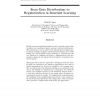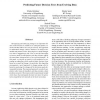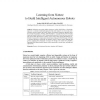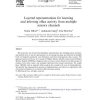2918 search results - page 47 / 584 » Learning qualitative models from numerical data |
NIPS
1994
13 years 9 months ago
1994
Ideally pattern recognition machines provide constant output when the inputs are transformed under a group G of desired invariances. These invariances can be achieved by enhancing...
ICDM
2008
IEEE
14 years 2 months ago
2008
IEEE
Recognizing and analyzing change is an important human virtue because it enables us to anticipate future scenarios and thus allows us to act pro-actively. One approach to understa...
IROS
2006
IEEE
14 years 1 months ago
2006
IEEE
Information processing within autonomous robots should follow a biomimetic approach. In contrast to traditional approaches that make intensive use of accurate measurements, numeric...
CVIU
2004
13 years 7 months ago
2004
We present the use of layered probabilistic representations for modeling human activities, and describe how we use the representation to do sensing, learning, and inference at mul...
ALMOB
2006
13 years 7 months ago
2006
Background: Bifurcation analysis has proven to be a powerful method for understanding the qualitative behavior of gene regulatory networks. In addition to the more traditional for...




